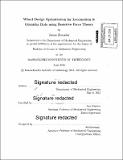Wheel design optimization for locomotion in granular beds using resistive force theory
Author(s)
Slonaker, James (James C.)
DownloadFull printable version (9.133Mb)
Other Contributors
Massachusetts Institute of Technology. Department of Mechanical Engineering.
Advisor
Ken Kamrin.
Terms of use
Metadata
Show full item recordAbstract
The application of Resistive Force Theory to further understand the dynamics of wheeled locomotion through granular materials was explored. Resistive Force Theory is a new terradynamic model that simplifies the calculation of the forces applied to bodies moving through granular media because it utilizes linear superposition and is easily scalable to any material of interest. First, a MATLAB simulation was created to test different wheel designs rotating through sand. The designs tested include a four-spoke design, consisting of four treads that have a hinge halfway down their length set to a specific angle, and a "superball" design, consisting of different solid shapes defined by the "superball" equation. The average velocity and power were found for each case to find an optimal design. It was found that four-spoke designs with an angle 6 < 1800 were optimal as they reached the highest velocities, while requiring the least power. Next, dimensional analysis was performed to find a global scaling relationship for the RFT wheel designs. Scaling laws for the power and velocity were found that allow different wheel designs and conditions to be simulated with an entirely new system. Using the simulation, it was found that the scaling law for a tire rotating on Mars could be tested on Earth up to a high degree of accuracy. Physical experiments, using 3D printed wheels and a sand testing bed, were carried out to further validate the scaling relationship. Both four-spoke and "superball" designs were tested and seem to show the general scaling trend expected.
Description
Thesis: S.B., Massachusetts Institute of Technology, Department of Mechanical Engineering, 2015. Cataloged from PDF version of thesis. Includes bibliographical references (page 91).
Date issued
2015Department
Massachusetts Institute of Technology. Department of Mechanical EngineeringPublisher
Massachusetts Institute of Technology
Keywords
Mechanical Engineering.